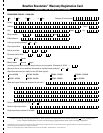
100
Q. Why is it so important I perform the Bowflex
®
exercises with a 4-second count on the lifting
and lowering?
A. Because a slow, smooth 4-second lifting followed
by a 4-second lowering involves more muscle
fibers more thoroughly than faster speeds of
movement. The more completely each involved
muscle fiber works simply means you’ll get
better muscle-building results.
Q. I’m confused about how to breathe during each
Bowflex
®
exercise?
A. Let’s say your goal is to do 10 repetitions on a
specific Bowflex
®
exercise that is performed in
the recommended 4-second lifting and 4-second
lowering style. Here are the proper breathing
guidelines to follow:
• Breathe normally during the first five repetitions.
• Take shorter, more shallow breaths during the
sixth, seventh, and eighth repetitions.
• Emphasize exhalation more than inhalation,
especially during the ninth and tenth
repetitions. Focus on good form and slow
movement.
• Do not hold your breath on any repetition.
Practice relaxing your face and neck. Do not
grit your teeth. Keep your eyes open and remain
alert.
Q. I’m not as disciplined and patient as I’d like
to be. How can I better stay on track with the
program?
A. One suggestion is to team up with a partner.
Most people are more motivated and make
better progress if they go through the program
with a friend. In selecting a training partner,
here are several things to keep in mind:
• Your partner should be similar to you in age
and condition.
• Your partner should be serious about getting
into shape and making a commitment. That
commitment means you’ll be exercising together
one hour, three times per week. Each of your
joint training sessions should take approximately
50 minutes: 25 minutes for your workout and 25
minutes supervising your partner’s workout.
• Your partner should be someone with whom you’ll
share a spirit of cooperation, not competition.
• Your partner should not be your spouse, brother,
sister, or other family member. You do not want
normal interpersonal problems to interfere with
the training.
Q. Why won’t you allow me to do aerobic dancing
on my off-days to speed up the loss of body fat?
A. Because doing so doesn’t speed up fat loss.
Aerobic dancing—and other activities such as
running, swimming, cycling, stair-stepping, and
racquetball—do not contribute significantly
to the fat-loss process. In fact, when added to
proper strength training they can actually retard
the reduction of fat.
Fat loss is retarded in two ways. Too much
repetitive activity prevents maximum muscle
building by using up your recover ability. A well-
rested recover ability is necessary for muscle
growth. Too much activity—especially if you are
on a reduced-calorie diet—causes you to get the
blahs and quickly lose your enthusiasm. If this
happens, you’re sure to break your diet.
The primary purpose of this program is to
lose fat in the most effective and most efficient
manner. Fat loss is prioritized and maximized by
building muscle at the same time. The muscle-
building process is optimized by a well-rested
recovery ability, which necessitates keeping your
strenuous and moderately strenuous activities to
a bare minimum.
Once you get your body fat to a low level, you
can add other activities—and I encourage you
to do so—to your weekly fitness schedule. For
now, follow the plan exactly as directed.
Q. What happens after six weeks? How do I
continue the program if I need to lose
more weight?
A. You should repeat the program for as long as it
takes you to reach your goal. For example, it took
Barry Ozer three six-week sessions—18 weeks—to
lose all of his excessive fat, which amounted to
75 pounds (34 kg). There are, however, a few
guidelines and modifications to apply.
Repeat the eating plan exactly as before: Men, go
back to 1500 calories a day for two weeks. Women,
go back to 1200 calories a day for two weeks.
Then, descend your calories in the same manner.
Keep your superhydration schedule at the
highest level. In other words, sip 1 5/8 gallons
(6.2 l) of ice-cold water each day.
Q & A


















